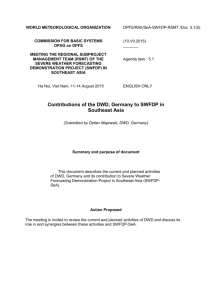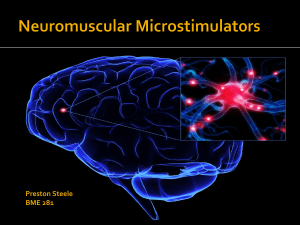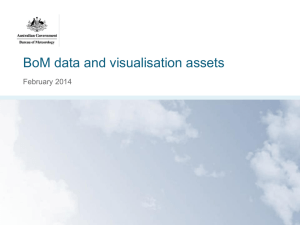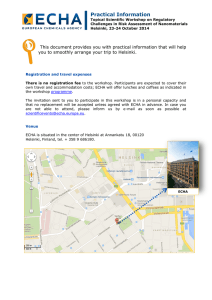Folie 1
advertisement
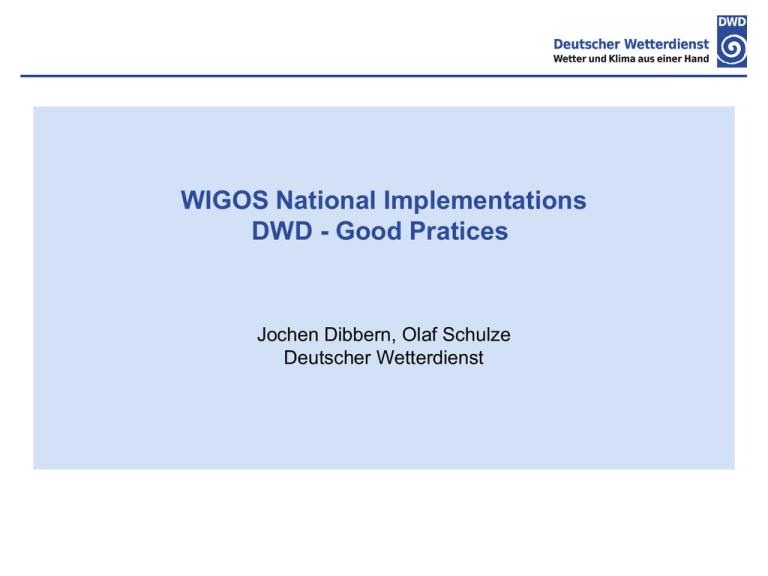
WIGOS National Implementations DWD - Good Pratices Jochen Dibbern, Olaf Schulze Deutscher Wetterdienst Key Area: WIR, user requirements, application areas Application areas for meteorological data acquisition Data as the basis of meteorological products and data for the following application areas numerical weather forecasts weather surveillance and warnings of severe weather phenomena surveillance of atmosphere and climate meteorological applications (aviation, ocean shipping, media etc.) climatological applications (consultancy, hydrology etc.) meteorological and environmental research RA-VI 16, Helsinki, 11-17 Sept 2013 2 Key Area: Design, planning and optimized evolution Stations operated by Deutscher Wetterdienst 4 Regional Oberserving Network Groups Hamburg, Potsdam, Offenbach, Munich 65 Stations with professional observers, 35 occupied 00-24 UTC, 30 only daytime 48 measuring radioactivity (air+precipitation) 28 RBSN Stations 11 Climate Reference (traditional equipment) 4 GSN-Stations (GCOS) 1 GUAN Station 1 GAW Station 114 Automated Weather Stations 17 Weather Radar Stations 9 Aerological Stations 4 Wind Profilers +34 Stat. as part of Bundeswehr Geoinfo Service RA-VI 16, Helsinki, 11-17 Sept 2013 5 Key Area: Design, planning and optimized evolution Additional Stations operated by DWD and Partners 1781 Voluntary Stations (climate; wind; precip), 1365 reporting online (24/1 reports per day) Ship-based: 740 Voluntary Observing Ships (VOS) 19 Ship AWS (24 reports/day) Last but not least …: 1292 Phenological stations (observing plants) 1500 Partner stations (approx) (motorways, fed.states, wind-energy, (nuclear) power-plants, universities, military) RA-VI 16, Helsinki, 11-17 Sept 2013 6 Key Area: Integrated observing system operation Monitoring and Quality Control Monitoring System and Quality Control to improve and assure the quality of the data technical data monitoring monitoring RA-VI 16, Helsinki, 11-17 Sept 2013 7 Key Area: Integrated observing system operation Tools and views for technical Monitoring Number of station requests per minute Number of SYNOPs produced per minute RA-VI 16, Helsinki, 11-17 Sept 2013 8 Key Area: Integrated Quality Management Quality control quality control of data step 1: automated quality control at station (realtime) step 2: automated quality control at central database (realtime); semi-automated quality control in central office (near realtime) (software tool „QualiMET“ - central version) Monitoring 24/7 since 2012/01 step 3: semi-automated quality control at DWD‘s regional network groups (software tool „QualiMET“; data processing after max. 10 days) step 4: semi-automated quality control of the values at the climatological observation times in central office (data processing within 2 years) each dataset will be flagged with a quality level each value will be flagged with different quality information RA-VI 16, Helsinki, 11-17 Sept 2013 9 Key Area: Integrated Quality Management Verification procedure QualiMET ( 5 stages) 1. Check for completeness Add or confirm 2. Check for climatological consistency Correct or confirm 3. Check for temporal consistency t1 t2 t3 t4 t5 1003 1003 Missing value 1002 1002 January Is the temperature measurement of 25°C really plausible ?? y y Correct or confirm t 4. Check for internal consistency t Is rainfall under clear sky correct? Correct or confirm Sunshine in the night? 5. Check for spatial consistency Correct or confirm 1000 1002 1003 1004 1005 1024 ? missing value RA-VI 16, Helsinki, 11-17 Sept 2013 10 Key Area: Integrated Quality Management Climatological reference stations To avoid wrong interpretation which is caused in the automatic measurements Conventional measurements for 10 years 3 measurement per day: 06:30, 13:30 and 20:30 UTC 11 stations are selected, each is representative for a special area of Germany To improve methods for homogenization of climate time series and data generation Brocken: Climatological reference station RA-VI 16, Helsinki, 11-17 Sept 2013 11 Key Area: Data and metadata management Principles for Metadata at DWD RA-VI 16, Helsinki, 11-17 Sept 2013 12 Key Area: Data and metadata management METADATA as a source for operative usage in DWD NinJO WebShop (data and more) .Data+Product Visualisation WMO Pub9VolA KU 2/NCDC FE Assimilation National Climat. Monitoring KU 1 ILM Climate Consultancy. StationManagement ANKONDA GPCC WebApplication Voluntary Meta-DATA. Weste MODES Climatological Products. Online-Stations MPG Payments (voluntary) generating reports (FM94,FM12,FM71) QualiMET QualityAssurance Phaenlogical ONLINE MAPs with Various Layers RA-VI 16, Helsinki, 11-17 Sept 2013 13 Key Area: Data and metadata management Amount of station Metadata Overview of the contents [count of largest categories in thousands]: WMO Main Stations (GSN, RBSN, RBCN ….) 13.000 Airports (with ICAO loc.ind.) reporting METAR/SPECI 5.000 German additional stations (voluntary, federal states) 12.000 Related partners (roads, renewable energy ….) 2.000 Voluntary observing ships and other marine vessels 9.000 Additional GPCC stations of all countries Currently counting over all: 75.000 117.000 RA-VI 16, Helsinki, 11-17 Sept 2013 15 Results WIGOS is part of the current DWD strategy 2014 - 2020 Implementation of the ten WIGOS key areas is mainly realized in DWD DWD will be the national integrator for meteorological observations and meta data Standardization of observations is realized in all meteorological networks of DWD (baseline network, secondary (= voluntary) network) European standardization in marine network started in last year Integration of additional partnership networks is planned RA-VI 16, Helsinki, 11-17 Sept 2013 16 Thank you for your attention ! WIGOS-Workshop Madrid 6-8 May 2013, DWD 17

